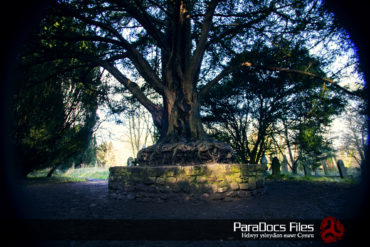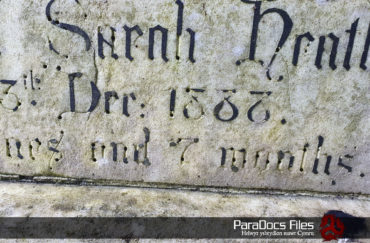MODIFIED
 The old part of Llandaff Cemetery was separated from the church and the surrounded marshland. A tributary which fed power to the corn mill that made the graveyard an island was blocked when the weir was built. This stopped the river taff from wandering and making the marshland useable for building. Signs of this tributary are all over, from the bridge at the side of the cathedral to some of the earthworks around the old graveyard. The cemetery is marked by old yew trees, the key feature is four yew trees which make a cross with paths leading to each one. These four yew trees are raised in old stone beds and their twisted roots clearly visible. There is a strong possibility the yew trees here were planted around 1120 AD or could be even older if this site was used for Pagan burials.
The old part of Llandaff Cemetery was separated from the church and the surrounded marshland. A tributary which fed power to the corn mill that made the graveyard an island was blocked when the weir was built. This stopped the river taff from wandering and making the marshland useable for building. Signs of this tributary are all over, from the bridge at the side of the cathedral to some of the earthworks around the old graveyard. The cemetery is marked by old yew trees, the key feature is four yew trees which make a cross with paths leading to each one. These four yew trees are raised in old stone beds and their twisted roots clearly visible. There is a strong possibility the yew trees here were planted around 1120 AD or could be even older if this site was used for Pagan burials.
 Little is written about the old cemetery and the four strange yew trees within it. At some point, this area was marshlands as was most of the low lying land in the area, and may have been tidal. The bridge and paths and trees appear on some old maps from 1886 AD, taking dates from gravestones. It is easy to surmise the old cemetery was built around 1120 AD by Bishop Gwrgan, and the bridge and paths are in line with the side of the cathedral. There is also reference the stone bridge across to one of the three islands of the Cathedral 1140 in documentation regarding the planning and building of what is now called the Bishops Palace. Dating the old cemetery by the biggest yew tree we have found give a rough date of planting between 400 AD and 800 AD.
Little is written about the old cemetery and the four strange yew trees within it. At some point, this area was marshlands as was most of the low lying land in the area, and may have been tidal. The bridge and paths and trees appear on some old maps from 1886 AD, taking dates from gravestones. It is easy to surmise the old cemetery was built around 1120 AD by Bishop Gwrgan, and the bridge and paths are in line with the side of the cathedral. There is also reference the stone bridge across to one of the three islands of the Cathedral 1140 in documentation regarding the planning and building of what is now called the Bishops Palace. Dating the old cemetery by the biggest yew tree we have found give a rough date of planting between 400 AD and 800 AD.
Another element that adds credence to the dating and history of the old graveyard, is the orientation of the crossed paths. During the summer solstice (21st June) the main path is in direct alignment with the sunrise, at an angle of 23.5 degrees to the equator. This would fit perfectly with druidic traditions of solstice worship. To add to this the Cathedral is not on the same alignment as these paths, and usually religious buildings and complexes all have the same orientations. In the case of Llandaff Cathedral, it is oriented so the east side faces Rome.
“The earliest mention of Druids comes during the 1st century BC, referring to druidae in Gaul (France) and Britain, who were wise men, observers of natural phenomena and moral philosophers. Similar to the druids were the bards (bardoi) – singers and poets, and diviners (vates), who interpreted sacrifices in order to foretell the future.” – Ancient druids of Wales
There is archaeological evidence that Iron Age Celtic rituals from between 300BC and AD100, took place in Wales. Stone Henge is over 4000 years old, and with current archaeological evidence, it was originally erected and used in Wales before being moved to Avebury, which shows that there has been some form of sun worship in Wales for over 4000 years. One other element that adds to the dating of this site is the ironworks in Llantrisant, with a road leading from there directly to the site of the old Graveyard. The 23.5-degree angle path in this graveyard is no accident and could place the sites founding anywhere from 2000BC to 100AD.
The building of Radyr weir in 1774 AD solidified the path of the river Taff, which made the marshland viable for building and use. Then in 1859, three pieces of land adjacent to the old cemetery were purchased by the Llandaff burial board, to form the new cemetery.
Radyr weir had it’s own tragedies, on the 17th July 1909 AD the death of a 9-year old was reported in the Cardiff Times. Lawrence Bennett Jr, the son of a marine engineer died while paying in the area around the weir.
The path of the tributary that served the corn mill can still be traced, using the bridge in the cemetery as a reference point. The corn mill was destroyed around 1930 AD during the construction of Western Avenue.
Notable Activity
 It is said that a ghost lady holding a baby who is believed to be Sarah Heath inhabits part of this graveyard. This ghost has been caught on camera by Carl Morgan who runs Elemental Paranormal, after being tipped off about unusual paranormal activity in the area. This ghostly sighting has been seen near the grave of a three-year-old child named Beatrix Amy, the daughter of the aforementioned Sarah Heath who is believed to have died in the 1300s. Carl claimed the name Sarah came to him a few months prior when he sought the advice of a psychic. Upon further investigation the date of the 1300s that have been used is incorrect. The true date is 1888, some of the leading on the gravestone has come off and typeface has flat top number 8s so they look like 3’s.
It is said that a ghost lady holding a baby who is believed to be Sarah Heath inhabits part of this graveyard. This ghost has been caught on camera by Carl Morgan who runs Elemental Paranormal, after being tipped off about unusual paranormal activity in the area. This ghostly sighting has been seen near the grave of a three-year-old child named Beatrix Amy, the daughter of the aforementioned Sarah Heath who is believed to have died in the 1300s. Carl claimed the name Sarah came to him a few months prior when he sought the advice of a psychic. Upon further investigation the date of the 1300s that have been used is incorrect. The true date is 1888, some of the leading on the gravestone has come off and typeface has flat top number 8s so they look like 3’s.
Dates Visited: Nighttime Accessibility Recce (11/01/2020), Daytime Photoshoot (15/01/2020), Main Recce (06/02/2020), Pre Assessmnet (01/08/2020)
More News
- Pre-Assessment: Road of the Dead / Llandaff Cemetery August 3, 2020Part of our methodology relies on a pre-assessment of the locations we are planning on investigating. Knowing what is there before we even start is a great way of removing ...
- Crew Recce of the Dead February 7, 2020Today’s crew recce of the Road of the Dead and Llandaff Cemetery was fun, most of the Team came along and we had an explore of the area. Gabriel Strange-Wood ...
- Something’s not happy as we investigate the Road of the Dead January 17, 2020Kallandra and I went on a location recce to the Road of the Dead and Llandaff Cemetery as there was a brief gap in the rain (this alone could be ...




